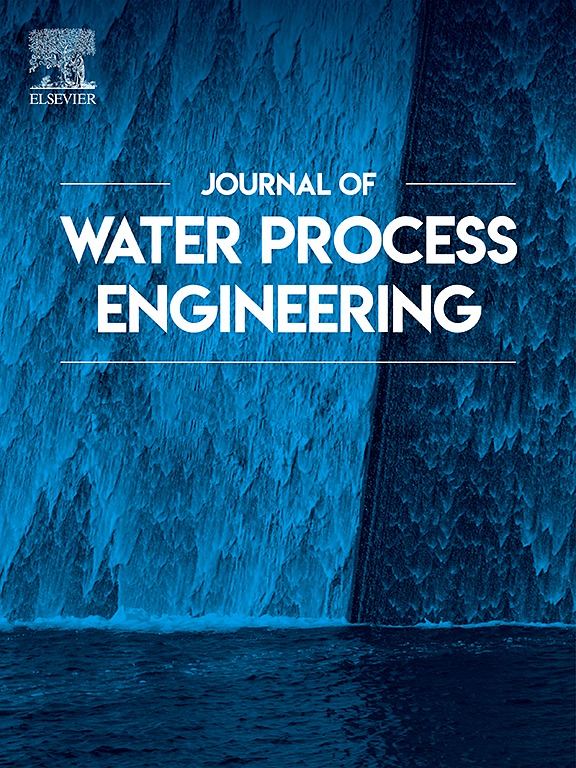One-step in-situ construction of efficient solar light-driven dual Z-scheme nanocomposite with specific nanoparticle arrangement for antibiotic degradation: Strategy, performance, and mechanism insights
IF 6.3
2区 工程技术
Q1 ENGINEERING, CHEMICAL
引用次数: 0
Abstract
Ternary dual Z-scheme photocatalysts prepared using conventional methods may cause photocatalyst nanoparticles with distinct interfaces and limited effective dual Z-scheme structures, which are unfavorable for the transfer of electrons among Z-scheme nanoparticles. In this study, a ternary dual Z-scheme CuO/CuBi2O4/Bi2O3 nanocomposite was constructed in-situ based on incomplete solid-phase chemical reactions, and applied to norfloxacin (NFX) degradation. The CuO/CuBi2O4/Bi2O3 photocatalyst prepared in one step has fuzzy interfaces and a specific nanoparticle arrangement, with CuBi2O4 located between CuO and Bi2O3 nanoparticles, which can form an effective dual Z-scheme photocatalytic system. The results showed that the degradation extent of NFX (5.0 mg/L) using CuO/CuBi2O4/Bi2O3 can reach 82.40 % within 240 min at 1.0: 1.0 M ratio of Cu(OH)2 and Bi(OH)3. The rate constant of 0.0052 min−1 using CuO/CuBi2O4/Bi2O3 nanocomposite is 2.17, 1.63, and 7.43 times higher than that of the CuO, Bi2O3, and CuBi2O4, respectively. The generation of h+, •OH, and •O2− was demonstrated during the degradation process. Additionally, the CuO/CuBi2O4/Bi2O3 nanocomposite photocatalyst exhibited high stability after four cycles and can degrade other antibiotics and dyes, such as tetracycline, crystal violet, acridine orange, and acid red B. Furthermore, the pathways and possible mechanisms for NFX degradation were proposed. This technology provides strategies for preparing ternary photocatalysts with specific nanoparticle arrangements and treating organic pollutants in water using sunlight.

求助全文
约1分钟内获得全文
求助全文
来源期刊

Journal of water process engineering
Biochemistry, Genetics and Molecular Biology-Biotechnology
CiteScore
10.70
自引率
8.60%
发文量
846
审稿时长
24 days
期刊介绍:
The Journal of Water Process Engineering aims to publish refereed, high-quality research papers with significant novelty and impact in all areas of the engineering of water and wastewater processing . Papers on advanced and novel treatment processes and technologies are particularly welcome. The Journal considers papers in areas such as nanotechnology and biotechnology applications in water, novel oxidation and separation processes, membrane processes (except those for desalination) , catalytic processes for the removal of water contaminants, sustainable processes, water reuse and recycling, water use and wastewater minimization, integrated/hybrid technology, process modeling of water treatment and novel treatment processes. Submissions on the subject of adsorbents, including standard measurements of adsorption kinetics and equilibrium will only be considered if there is a genuine case for novelty and contribution, for example highly novel, sustainable adsorbents and their use: papers on activated carbon-type materials derived from natural matter, or surfactant-modified clays and related minerals, would not fulfil this criterion. The Journal particularly welcomes contributions involving environmentally, economically and socially sustainable technology for water treatment, including those which are energy-efficient, with minimal or no chemical consumption, and capable of water recycling and reuse that minimizes the direct disposal of wastewater to the aquatic environment. Papers that describe novel ideas for solving issues related to water quality and availability are also welcome, as are those that show the transfer of techniques from other disciplines. The Journal will consider papers dealing with processes for various water matrices including drinking water (except desalination), domestic, urban and industrial wastewaters, in addition to their residues. It is expected that the journal will be of particular relevance to chemical and process engineers working in the field. The Journal welcomes Full Text papers, Short Communications, State-of-the-Art Reviews and Letters to Editors and Case Studies
 求助内容:
求助内容: 应助结果提醒方式:
应助结果提醒方式:


